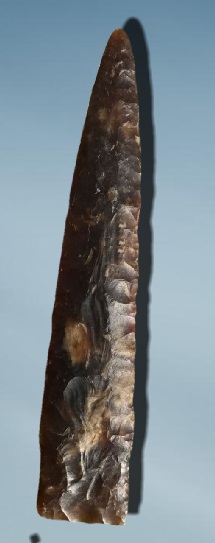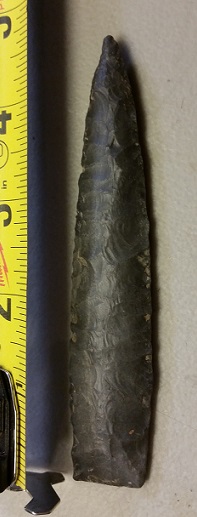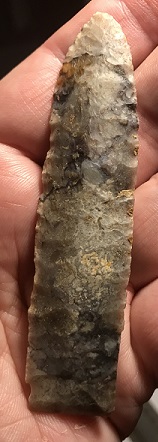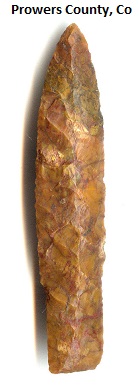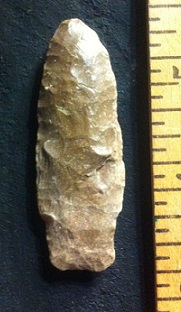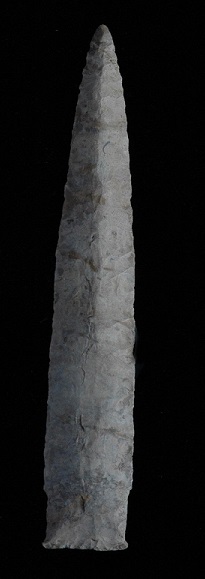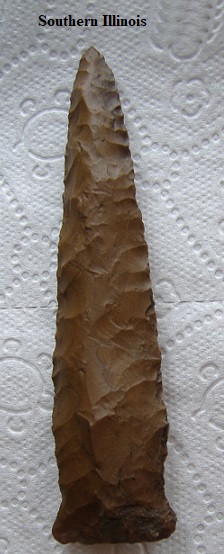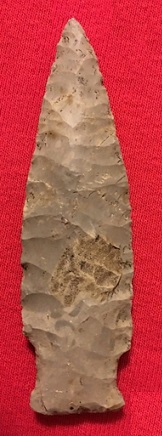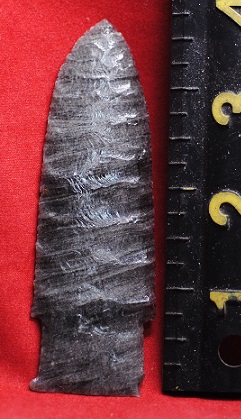Outline is Representative of Size and Shape:
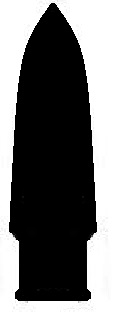 Eden Eared
Eden Eared

 Eden Eared
Eden Eared Name Details:
Identified By: H. Maria Wormington
Named For: Eden Valley, Southwestern Wyoming
Date Identified: 1957
Type Site: Finley Bison Kill Site, Sweetwater, Wyoming
Identified By: H. Maria Wormington
Named For: Eden Valley, Southwestern Wyoming
Date Identified: 1957
Type Site: Finley Bison Kill Site, Sweetwater, Wyoming
Point Validity:
Valid type
Wormington was a renowned anthropologist and served as Curator Emeritus for the Denver Museum of Natural History. She studies the Fremont Culture and identified their origins, but she is most known as being the foremost expert on Paleo Archeology. This point was published in a professional publication and is considered a valid type.
Wormington was a renowned anthropologist and served as Curator Emeritus for the Denver Museum of Natural History. She studies the Fremont Culture and identified their origins, but she is most known as being the foremost expert on Paleo Archeology. This point was published in a professional publication and is considered a valid type.
Eden / Eared Eden
AKA: Yuma (Eden) / Cody Eared (Eden Eared)Cluster: Plano Stemmed Cluster
Description of Physical Characteristics and Flaking Pattern:
This is a long narrow medium to large lanceolate shaped stemmed point with a median ridge cross section. The blade is primarily excurvate and is commonly long and narrow. The shoulders are weak to absent and vary from horizontal to having an upward angle. The stem is7straight and square, however, some examples have ears at the base of the stem. The base may vary from straight to convex, basal grinding is common on this point. This point is manufactured using serial pressure flaking forming a symmetrical scarring pattern forming a collateral to parallel pattern.
Size Measurements:
Total Length - 50 to 150 mm (average 55 to 60 mm), Stem Length - 10 to 20 mm (average 15 mm or 1/3 to 1/10 the total length), Blade Width - 15 to 25 mm (average 17 to 20 mm), Stem Width - 3 to 6 mm narrower than blade (average 14 to 19 mm).
Total Length - 50 to 150 mm (average 55 to 60 mm), Stem Length - 10 to 20 mm (average 15 mm or 1/3 to 1/10 the total length), Blade Width - 15 to 25 mm (average 17 to 20 mm), Stem Width - 3 to 6 mm narrower than blade (average 14 to 19 mm).
Additional Comments:
This point was originally called the Yuma point after examples that were surface finds from Yuma County Colorado. These points were then found in situ at the Finley site and named Eden points after the local town.
These points are similar to the Scottsbluff points but differ in the blade is narrow with weak shoulders. The cross section of the Eden type has a median ridge giving the cross section a diamond which is lacking in the Scottsbluff type (Justice, 1987).
Bradley and Stanford (1987) conducted a study of Eden points and Scottsbluff points in order to define the difference between the two type. Many examples were found to be distinct enough to determine a Eden type from the Scottsbluff type, but they found that there were many examples that fell in between the two types. They argue that the Scottsbluff type and the Eden type may represent a continuum of a single type. The re-sharpening of the Scottsbluff type may account for both the median ridge and the reduced shoulders that is the key to identification between the two types.
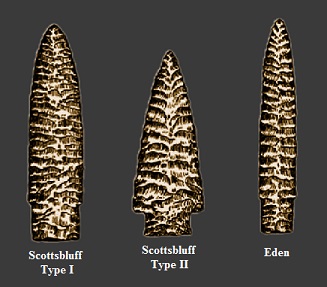 The Eared variation of the Eden type has only been identified in Wisconsin (Justice 1987).
The Eared variation of the Eden type has only been identified in Wisconsin (Justice 1987).
This point was originally called the Yuma point after examples that were surface finds from Yuma County Colorado. These points were then found in situ at the Finley site and named Eden points after the local town.
These points are similar to the Scottsbluff points but differ in the blade is narrow with weak shoulders. The cross section of the Eden type has a median ridge giving the cross section a diamond which is lacking in the Scottsbluff type (Justice, 1987).
Bradley and Stanford (1987) conducted a study of Eden points and Scottsbluff points in order to define the difference between the two type. Many examples were found to be distinct enough to determine a Eden type from the Scottsbluff type, but they found that there were many examples that fell in between the two types. They argue that the Scottsbluff type and the Eden type may represent a continuum of a single type. The re-sharpening of the Scottsbluff type may account for both the median ridge and the reduced shoulders that is the key to identification between the two types.
 The Eared variation of the Eden type has only been identified in Wisconsin (Justice 1987).
The Eared variation of the Eden type has only been identified in Wisconsin (Justice 1987). Distribution: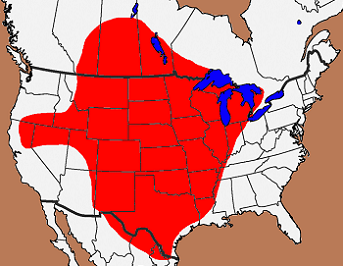

Distribution Comments:
This point is commonly found in Wyoming to Colorado and western Nebraska. They are common on the High Places from New Mexico to Canada. They are found in into Texas and Ontario. Justice (1987) notes that the Cody Complex has not been found into the Ohio River basin, but similar points have been found resembling Cody Complex type points, but are generally typed as McConnell Lanceolate, Stringtown, and Ohio Stemmed type points.
This point is commonly found in Wyoming to Colorado and western Nebraska. They are common on the High Places from New Mexico to Canada. They are found in into Texas and Ontario. Justice (1987) notes that the Cody Complex has not been found into the Ohio River basin, but similar points have been found resembling Cody Complex type points, but are generally typed as McConnell Lanceolate, Stringtown, and Ohio Stemmed type points.
Age / Periods:
Date: 9,250 - 8,850 B.P.
Cultural Period: Transitional Paleo to Early Archaic
Glacial Period: Early Holocene
Culture: Cody Complex / Culture
Date: 9,250 - 8,850 B.P.
Cultural Period: Transitional Paleo to Early Archaic
Glacial Period: Early Holocene
Culture: Cody Complex / Culture
Age Details:
Similar Points:
Agate Basin, Alder, Angostura, Browns Valley, Coryell, Early Stemmed, Firstview, Hollenberg, Kramer, Nebo Hill, San Jon, Searcy, Stone Square Stem, Windust
Agate Basin, Alder, Angostura, Browns Valley, Coryell, Early Stemmed, Firstview, Hollenberg, Kramer, Nebo Hill, San Jon, Searcy, Stone Square Stem, Windust
Other points in this cluster / Related / Associated Points:
Alberta, Cody Knife, Holland, Scottsbluff
Alberta, Cody Knife, Holland, Scottsbluff


